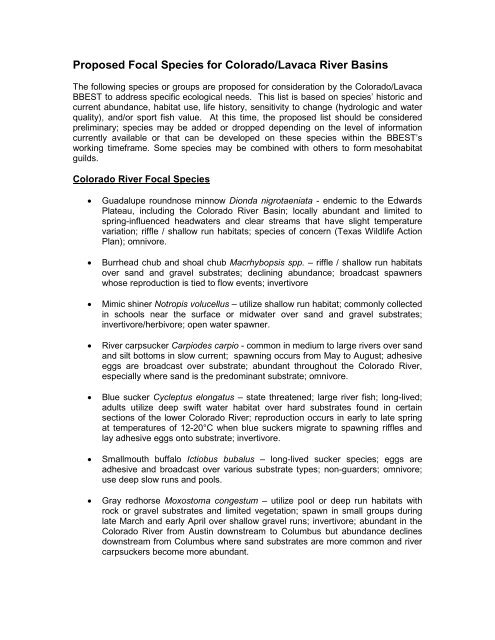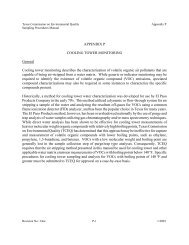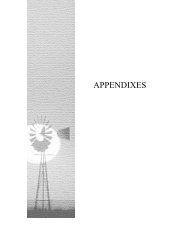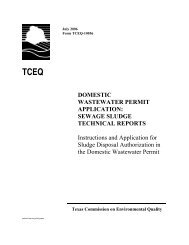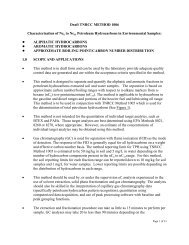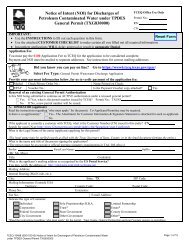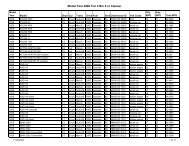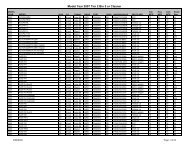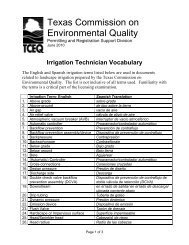You also want an ePaper? Increase the reach of your titles
YUMPU automatically turns print PDFs into web optimized ePapers that Google loves.
Proposed <strong>Focal</strong> <strong>Species</strong> for <strong>Colorado</strong>/Lavaca <strong>River</strong> Basins<br />
The following species or groups are proposed for consideration by the <strong>Colorado</strong>/Lavaca<br />
BBEST to address specific ecological needs. This list is based on species’ historic and<br />
current abundance, habitat use, life history, sensitivity to change (hydrologic and water<br />
quality), and/or sport fish value. At this time, the proposed list should be considered<br />
preliminary; species may be added or dropped depending on the level of information<br />
currently available or that can be developed on these species within the BBEST’s<br />
working timeframe. Some species may be combined with others to form mesohabitat<br />
guilds.<br />
<strong>Colorado</strong> <strong>River</strong> <strong>Focal</strong> <strong>Species</strong><br />
• Guadalupe roundnose minnow Dionda nigrotaeniata - endemic to the Edwards<br />
Plateau, including the <strong>Colorado</strong> <strong>River</strong> Basin; locally abundant and limited to<br />
spring-influenced headwaters and clear streams that have slight temperature<br />
variation; riffle / shallow run habitats; species of concern (Texas Wildlife Action<br />
Plan); omnivore.<br />
• Burrhead chub and shoal chub Macrhybopsis spp. – riffle / shallow run habitats<br />
over sand and gravel substrates; declining abundance; broadcast spawners<br />
whose reproduction is tied to flow events; invertivore<br />
• Mimic shiner Notropis volucellus – utilize shallow run habitat; commonly collected<br />
in schools near the surface or midwater over sand and gravel substrates;<br />
invertivore/herbivore; open water spawner.<br />
• <strong>River</strong> carpsucker Carpiodes carpio - common in medium to large rivers over sand<br />
and silt bottoms in slow current; spawning occurs from May to August; adhesive<br />
eggs are broadcast over substrate; abundant throughout the <strong>Colorado</strong> <strong>River</strong>,<br />
especially where sand is the predominant substrate; omnivore.<br />
• Blue sucker Cycleptus elongatus – state threatened; large river fish; long-lived;<br />
adults utilize deep swift water habitat over hard substrates found in certain<br />
sections of the lower <strong>Colorado</strong> <strong>River</strong>; reproduction occurs in early to late spring<br />
at temperatures of 12-20°C when blue suckers migrate to spawning riffles and<br />
lay adhesive eggs onto substrate; invertivore.<br />
• Smallmouth buffalo Ictiobus bubalus – long-lived sucker species; eggs are<br />
adhesive and broadcast over various substrate types; non-guarders; omnivore;<br />
use deep slow runs and pools.<br />
• Gray redhorse Moxostoma congestum – utilize pool or deep run habitats with<br />
rock or gravel substrates and limited vegetation; spawn in small groups during<br />
late March and early April over shallow gravel runs; invertivore; abundant in the<br />
<strong>Colorado</strong> <strong>River</strong> from Austin downstream to Columbus but abundance declines<br />
downstream from Columbus where sand substrates are more common and river<br />
carpsuckers become more abundant.
• Channel catfish Ictalurus punctatus – sport fish; nest builder; omnivore; juveniles<br />
use riffle habitat, whereas adults prefer run or pool habitat.<br />
• Flathead catfish Pylodictis olivaris – large long-lived catfish; utilize deeper areas<br />
of rivers with slow to moderate velocity and heavy cover such as rocks or<br />
submerged wood; builds nests in natural cavities; young utilize riffle habitat;<br />
piscivorous.<br />
• Bluegill Lepomis macrochirus – utilize pool habitat, feeding mainly on<br />
invertebrates; nest builder that spawns in spring and summer.<br />
• Largemouth bass Micropterus salmoides – sport fish; found in low velocity<br />
mesohabitats such as pools and backwaters; piscivorous; nest builder.<br />
• Guadalupe bass Micropterus treculii - endemic to the Edwards Plateau region of<br />
central Texas; habitat utilization changes with life stage; juveniles occupy shallow<br />
runs over various substrate types; adults utilize swift deep runs and pools<br />
downstream of riffles where they prey on insects, crayfish, and small fish;<br />
spawning occurs in the spring; nests constructed by the male in shallow water;<br />
present throughout the <strong>Colorado</strong> <strong>River</strong> Basin but most abundant in clear water<br />
reaches throughout the middle sub-basin watersheds including the Pedernales,<br />
Llano, and San Saba drainages; species of concern (Texas Wildlife Action Plan).<br />
• Texas logperch Percina carbonaria – endemic to the Edwards Plateau region of<br />
central Texas; inhabit rocky riffles and runs with relatively fast current; feed on a<br />
variety of aquatic insect larvae; spawn from January to June in the <strong>Colorado</strong><br />
<strong>River</strong>; eggs and larvae can tolerate temperatures between 22 to 26°C; pollution<br />
intolerant species.<br />
• Dusky darter Percina sciera – prefers riffle/run habitat, often associated with<br />
other cover such as boulders or logs; spawn over gravelly substrates from<br />
February through June in the <strong>Colorado</strong> <strong>River</strong>; brood hider; invertivore.<br />
• Macrobrachium spp. – migratory species; special concern species (Texas<br />
Wildlife Action Plan).<br />
Lavaca <strong>River</strong> <strong>Focal</strong> <strong>Species</strong><br />
• American eel Anguila rostrata – catadromous; piscivore; different life stages may<br />
use varying habitats; selected for longitudinal connectivity given free run of<br />
Lavaca <strong>River</strong>; special concern (Texas Wildlife Action Plan).<br />
• Ribbon shiner Lythrurus fumeus – broadcast spawner; invertivore;<br />
representative of pools or backwaters with weak current;<br />
• Channel catfish Ictalurus punctatus – sport fish; nest builder; omnivore; juveniles<br />
use riffle habitat, whereas adults prefer run or pool habitat.
• Bluegill Lepomis macrochirus – utilize pool habitat, invertivore; nest builder that<br />
spawns in spring and summer.<br />
• White crappie Pomoxis annuaris – nest builder; piscivore; prefers backwater<br />
habitats.<br />
• Slough darter Etheostoma gracile – lay adhesive eggs that are attached to plant<br />
material; invertebrate feeder; prefers backwater or low current habitats.<br />
• Dusky darter Percina sciera – prefers riffle/run habitat, often associated with<br />
other cover; brood hider; invertivore.<br />
• Pugnose minnow Opsopoedus emiliae – nest spawner; detritivore; edge habitat<br />
usually associated with plants.<br />
• Blue sucker Cycleptus elongatus – state threatened; large river fish; long-lived;<br />
adults utilize deep swift water habitat over hard substrates; reproduction occurs<br />
in early to late spring at temperatures of 12-20°C when blue suckers migrate to<br />
spawning riffles and lay adhesive eggs onto substrate; invertivore. Though listed<br />
for the Lavaca basin in several sources, additional distributional information<br />
should be investigated since occurrences are not documented in available<br />
collection records.<br />
• Smallmouth buffalo Ictiobus bubalus – long-lived sucker species; rock and gravel<br />
spawners; omnivore; use deep slow runs and pools.<br />
• Macrobrachium spp. – migratory species; special concern species (Texas<br />
Wildlife Action Plan).


